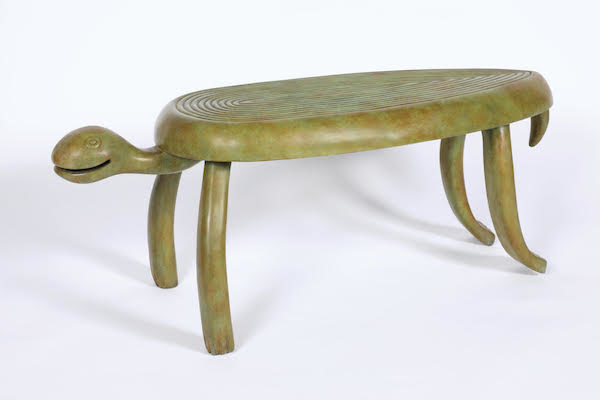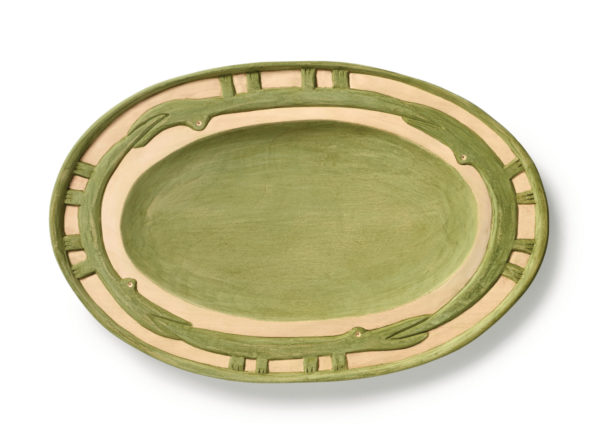Visual Arts Review: Contemporary and Antediluvian — Judy McKie At Gallery NAGA
By Mark Favermann
Judy McKie draws on a personal mythology in which animal and plant forms are abstracted yet recognizable, anthropomorphic though strangely primeval.
Judy Kensley McKie at Gallery NAGA, 67 Newbury Street, Boston, MA, through December 14.

“Turtle Table,” Cast Bronze, by Judy Kensley McKie, 2018. Photo by Scott McCue.
By any measure, Judy Kensley McKie is a special artist. Her art resonates with a distinctive quality that takes it beyond the purely visual, that expands on conventional ideas of imagery and imagination, fine materials and technique, even beyond her extraordinary craftsmanship. The current exhibition at Boston’s Gallery NAGA provides ample evidence of this gift: there is a resounding sense of joy in every one of her stunning and functional pieces.
A master at creating art furniture, McKie has garnered almost every honor that can be bestowed on an artist/craftsman. These include two National Endowment of the Arts Fellowships, in 1979 and 1982; a Massachusetts Artists Foundation Fellowship; a Louis Comfort Tiffany Foundation Award (1989); a Fellow of the American Craft Council award (1998); The James Renwick Alliance Master of Medium Award for Furniture (2005); and the Furniture Society Award of Distinction (2005).
Over the years she has exhibited extensively in solo and group shows. Her work is in a large number of permanent collections in museums, including the Boston Museum of Fine Arts, the Museum of Art at the Rhode Island School of Design, the Smithsonian American Art Museum at the Renwick Gallery, the Smith College Art Museum, the Yale University Art Gallery, the Rose Art Museum, the deCordova Sculpture Park and Museum, the Addison Gallery of American Art, the Mint Museum, San Francisco’s de Young Museum, the Toledo Museum of Art, and the Philadelphia Museum of Art.
For me, what is most wonderful about McKie’s work is that each piece she creates is a stand-alone sculptural object. Flora and fauna imagery are major ingredients in her visual vocabulary. But these are not naturalistic representations: McKie’s vegetation and creatures are endowed with the spirit of a natural yet abstract nature. In addition, her artwork reflects an extraordinary fusion of hard and soft, serious as well as playful—somehow simple and complex at the same time. A sly sense of whimsy is also an inevitable aspect of her art and craft.
McKie draws on a personal mythology in which animal and plant forms are abstracted yet recognizable, anthropomorphic though creatively primeval Delight is intertwined with form and function via a graceful intensity. She creatively engages with various materials, ranging from wood to various shades of eloquently finished bronze. She uses Milk Paint, a favorite material, for coloration on carved and painted basswood.
In this Gallery NAGA show of primarily larger functional objects and furniture, McKie’s training as a painter at the Rhode Island School of Design (RISD) is evident in her sense of proportion and scale, her use (or non-use) of color, and even her thoughtful placement of her pieces.

“Monkey Table,” Cast Bronze, by Judy Kensley McKie, 2018. Photo by Scott McCue
A number of pieces in the show are showstoppers. A terrific piece at the entrance, Swan Side Table (2018), is cast in a light bronze, luminously gray colored. Possessing plenty of personality, the two swans seem to be in an evocative conversation with each other. Also exhibiting McKie’s striking talent is the cast bronze (and glass topped) Monkey Table (2018). The table elegantly expresses the elongated primate anatomy in a way that is amusing, but also suggests strength and utility.
The sturdy Pony Table (2017) both references the dark bronze of Ancient Greek statuary and gives off fanciful vibes. The piece’s eloquent structure is reminiscent of a dreamlike Hellenistic illustration. Looking at this horse from a distance, the viewer can easily imagine a Spartan warrior riding on its back. Or might it really be a high-stepping Arabian stallion? One of McKie’s earlier pieces of art furniture is here: her beautifully carved and decoratively enhanced black-and-white Circle Table (1997). Its solid form generates the same visual pleasure — in three-dimensional form — of a powerful abstract painting. Blanket Chest with Trees (2017) shows how skillfully McKie can translate blank wood into an indelible vision. This piece of beautiful furniture declares itself, almost immediately, as the archetype of a family legacy or estate piece.
The cast bronze Crocodile Bench (2018) is a smooth and beautiful green rectangle shape in which an inscribed crocodile is stretched across all four vertical sides — the creature is holding its tail in its mouth. The piece is simple but visually complex: yes, it is a fantasy figure, but it may actually be more real than a more accurately detailed rendering or photograph. The image seems to reference the croc in Peter Pan — though it is also very much part of McKie’s personal zoo.

“Alligator Tray,” Carved Basswood and Milk Paint, by Judy Kensley McKie, 2018. Photo: Stewart Clements.
The smallest piece in this exhibit is the Alligator Tray (2018). It is made from basswood and Milk Paint. The reptiles’ tails are in each others’ mouths, making this image tantalizingly reminiscent of a children’s book illustration. The tray seems to move — even as it is standing still. Who would have the heart to cover it over with food?
The green bronze Turtle Table (2018) is perhaps my favorite piece. There is both humor and grace here, function and form combined via the sculptural quality of a visually memorable silhouette. The likeable turtle smiles mysteriously: what does it know or see that we don’t?
McKie eloquently blurs the line between utilitarian furniture and sculpture by adeptly blending the pragmatic and the aesthetic. Her pieces emanate the physical presence of rare objects that have been unearthed from an archaeological treasure trove, reflections of her wry personal mythology. Yet McKie always makes use of stylish modern abstraction. The results are rare examples of the functionally beautiful that are a joy to behold.
An urban designer and public artist, Mark Favermann has been deeply involved in branding, enhancing, and making more accessible parts of cities, sports venues, and key institutions. Also an award-winning public artist, he creates functional public art as civic design. Mark created the Looks of the 1996 Centennial Olympic Games in Atlanta, the 1999 Ryder Cup Matches in Brookline, MA, and the 2000 NCAA Final Four in Indianapolis. The designer of the renovated Coolidge Corner Theatre, he is design consultant to the Massachusetts Downtown Initiative Program. Since 2002, Mark has been a design consultant to the Red Sox. Mark is Associate Editor of Arts Fuse.
